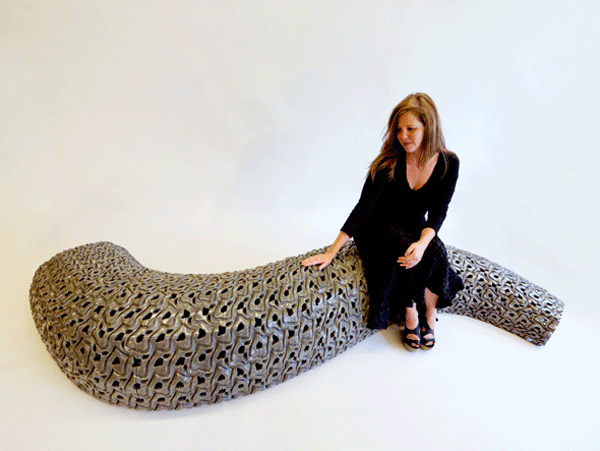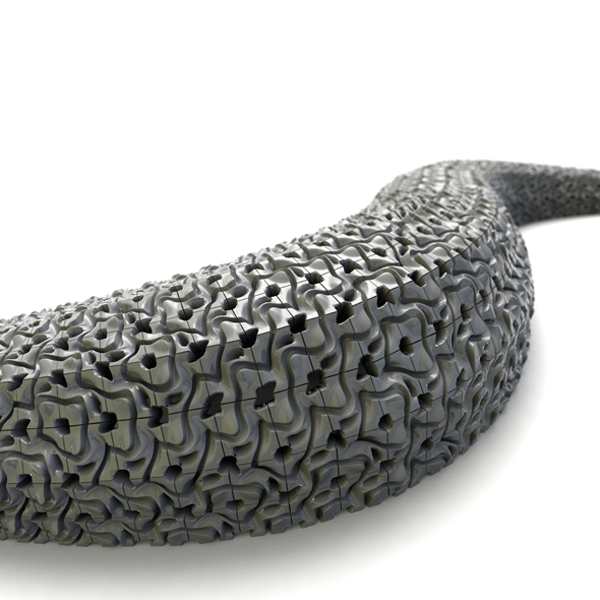
You never know what you’ll see at Maker Faire, but you’re always guaranteed to be inspired by the balance of the whimsical and the practical. Some projects are created solely to make you smile, while others are destined to make an impact on the future of how things are made. Representing the latter is a research team from the College of Environmental Design at UC Berkeley, led by architect, book author, and Assistant Professor of Architecture Ronald Rael. The team has hacked four Z Corp 310 3D printers and developed a process for the creation of 3D printed buildings, building components, and interior accessories. We spoke with Professor Rael to learn more about the research.
1. Tell us about the 3D printing research your group at UC Berkeley’s College of Environmental Design is conducting.
Utilizing the Fabrication Shop and CAD/CAM Lab at the College of Environmental Design (CED), I’ve been exploring methods by which commercial 3D printers can be used to print parts with materials that are durable, inexpensive, and able to be assembled into architectural/building components.
2. What was the impetus for hacking the Z Corp 310 3D printer? What was the R&D process?
We were very interested in additive manufacturing methods, but for architecture the materials typically used in 3D printing are very expensive and produce parts with limited durability. The question raised then was: how can we produce durable structural parts using 3D printing less expensively? In the research, we explored ceramics with success, but the length of time from printing to firing to glazing was far too slow to reflect the “rapid” nature of rapid manufacturing. We then switched to cement. Early on we were assisted by Professor Mark Ganter at the University of Washington. He demonstrated methods for rethinking the materials used in commercial 3D printers.
3. The Seat Slug pieces were printed using a cement-based polymer. How was that material developed and what other types of alternative materials can the printers now use?
The material was developed as a result of the knowledge gained in printing with ceramics. We had access to some amazing ceramics experts: Professor Richard Shaw and ceramic technician and artist Ehren Tool. Through their encouragement, we tackled the most difficult ceramic material: porcelain. After many months of struggling with the process, and good successes, we thought about using cements as catalysts to create the parts.
While we were never able to achieve structural strength from the cement mixtures, our attempts to hydrate the materials by post-processing them with water-based epoxies proved to be quite successful. Our parts, made of a cement polymer, proved to be as strong if not stronger than typical concrete. From there a range of material possibilities opened up. We were able to explore a variety of materials through trial and error, as well as different material combinations. Among the materials tested were salt, wood, bone, cement, plaster, sand, soil-cement, clay, and paper.
4. Describe the implications this research has on architecture and fabrication.
One of the implications this has had is that we’ve realized, given our limitations in size with commercially available 3D printers, that we were able to develop strategies for making many small parts using what we call a “printer farm.” Our CAD/CAM Lab now has four machines to keep production of parts going using several printers at once as opposed to using one large machine. However, the use of larger machines is idea we are currently thinking about in collaboration with a Bay Area artist, fabricator, and software company.
Additionally, we can produce forms that would normally be very difficult or impossible to create using other techniques. While many production methods, such as laser cutting or CNC routing, can only use flat materials, this research opens up the possibility of creating much more exciting shapes — the end of “flat-only” fabrication.
We are also using materials that look and feel like real materials. Most 3D printer materials seem like “non-materials” — generic white powders that do not have the quality of materiality that architects and designers appreciate. These new materials are translucent, weather beautifully, and, as in the case of the wood material, even have grain made by the layering process of additive manufacturing (digital wood!).
5. How has the research been received so far?
The Seat Slug has received much attention, making its rounds on the internet and in several print publications. High-end fabricators have contacted me to begin production of architectural assemblies for complex components that are difficult to fabricate. However, large scale production is not something that is possible with our four machines. Currently, I am speaking with collaborators to work on ways to bring this into large-scale production.
At CED we are now only running homemade powders on these machines. Students are able to explore the possibility of much larger models and create their own new material combinations. Paper and salt came out of a recent thesis studio. Next year we will be exploring these possibilities to a greater extent in a year-long research studio within the Masters program.
6. How big is the research team and what types of skill sets are represented among the folks working on this project?
The research began when I received a grant from the Hellman Family Fund, which supports innovative research for young professors. Through seminars and studios with graduate students, graduate and undergraduate research assistants, faculty and staff, collaborations with my own creative practice with Virginia San Fratello (Rael San Fratello Architects), and a new start-up focusing on 3D printing for the built environment (www.emergingobjects.com) the size of the team varies. While I maintain a role at the center of the research, I hope that by disseminating this research to students, they will take it further.
7. What’s the most important thing you’ve learned about collaboration from working on this project?
It is important to be open and collaborative, to not keep secrets. It seems the more that ideas are openly shared, the more possibilities arise.
8. How did your team hear about Maker Faire and why did you decide to participate?
CED’s Fabrication Shop Manager Jamie Banes suggested our participation. He, along with our CAD/CAM Lab Manager Christopher K. Palmer, is involved in the Bay Area maker culture. These two are also very influential with our students and faculty. We have collaborated on some projects using concrete with students and thought it would be a nice fit to come to Maker Faire to show the work being done at CED.
9. How will the research be brought to life at Maker Faire?
We are bringing several of our experiments: the Seat Slug, and many examples of our wood, salt, and paper 3D-printed objects. We will also bring some 3D printers and have them in operation while at Maker Faire.
10. What advice would you give to young makers just getting started?
One great resource that helped us get started is Professor Mark Ganter’s website at open3dp.me.washington.edu. I can also be contacted at the Department of Architecture at CED, and would be glad to help however I can. But more specifically, people need to just dive in and MAKE without the fear of things not turning out how they expected. Many of our best discoveries came from our biggest mistakes and accidents.
Thank you Professor Rael! We’re looking forward to seeing the Slug Seat and the hacked printers, and will be keeping an eye on how the research develops.
For folks who want to join us at Maker Faire Bay Area, taking place on May 19 and 20 in San Mateo, head over to the Faire site for all the information you need, including how to pick up discount tickets before May 10.
ADVERTISEMENT









